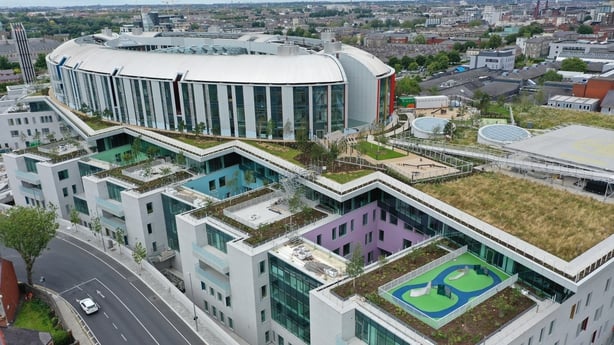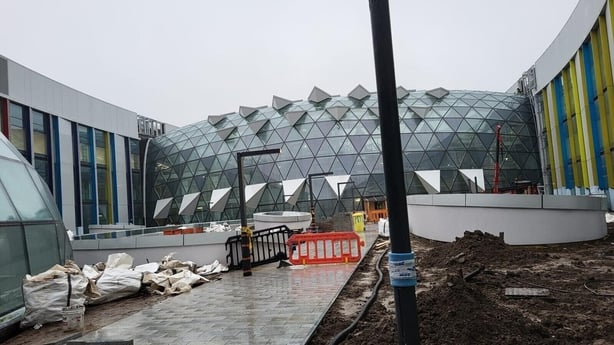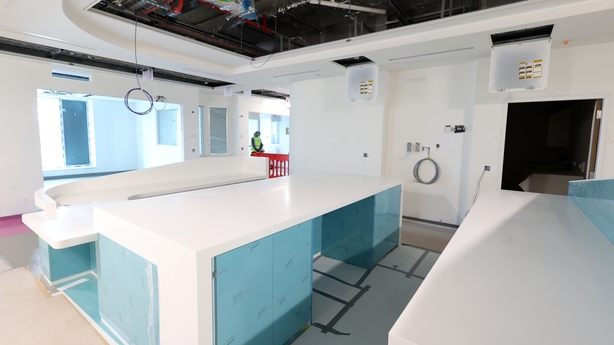The new National Children's Hospital is a project in deep crisis and in need of emergency attention.
At worst, there is the danger that the clash between the National Paediatric Hospital Development Board (NPHDB) and the builders, BAM, could result in the project coming to a halt.
Whatever the final outcome, this will likely end up being the most expensive hospital of its kind, ever built.
Even at this late stage, with the hospital said to be 94% complete, no one can say when it will open for patients and what it will finally cost.
Few doubt that the final bill will be less than €2.5 billion, after an original cost of €650 million.
It is expected that the actual cost will not be known until long after the doors finally open for patients, as it is likely legal battles will continue for some time over extra cost claims by BAM.
For the country's families and children, ultimately the patients who are to benefit, these events playing out are a nightmare.
The NPHDB is a special purpose vehicle, that was set up to design, build and equip the new facility.
Planning permission
After planning permission was granted in 2016, BAM were awarded the contract.
Children's Health Ireland (CHI) will operate the new facility and currently the existing three children's hospital are under its umbrella.
The HSE will fund the services.
The project is now mired in claim and counterclaim.
This week, the NPHDB alleged that the builders have failed to adequately resource the project.
The NPHDB told the Oireachtas Health Committee that the biggest factors contributing to the delay were the builders offering rooms and areas in the hospital as complete, when they were not.
David Gunning, Chief Officer of the Development Board, said that BAM have failed to manage the project execution, and that the main completion date had shifted 14 times in the last year.
Design changes
The NPHDB has not accepted the builder’s new main completion date of June 2025.
The Development Board also rejects suggestions that design changes have driven up the main costs and are contributing to ongoing delays.
Some of the strongest words used by Mr Gunning were claims that BAM was taking the hospital hostage and trying to extract as much money as possible from the taxpayer.
In a detailed response, BAM said these were misleading, ill-informed and incorrect allegations.
It added that the claims are not helpful to ensuring the complex and vital project is completed at the earliest possible juncture.
We need your consent to load this rte-player contentWe use rte-player to manage extra content that can set cookies on your device and collect data about your activity. Please review their details and accept them to load the content.Manage Preferences
One of the key criticisms by BAM is that when the project moved to above ground works in January 2019, the hospital design had not been completed by the NPHDB.
They say the contract clearly stated that the design should have been finalised at that point, and that many of the current issues flow from the lack of a final design in 2019.
The company says there have been 23,990 new, revised drawings.
Most recently in January a compliance audit directed major changes.

BAM said these changes are required to correct thousands of design errors which were identified by the NPHDB design team.
The changes require the removal and relocation of thousands of ceiling-mounted services across the hospital, including smoke detectors, light sensors, CCTV cameras, emergency signage and sprinkler heads.
Most ceilings in the hospital are said to be affected.
Ongoing extra costs
Mr Gunning said he was "sick" of the delays and promised that the builders will not be getting "one penny more" of increased cost for the project.
Sinn Féin’s Spokesperson on Health David Cullinane took Mr Gunning to task on this position, pointing out that it will not necessarily be up to him to determine that - it may be the courts.
To drive home this point, BAM noted that an adjudication/conciliation case resulted in the builders being awarded €107m in May for extra claims.
This money has already been paid, although the NPHDB still has an issue with this recommendation/adjudication.

Róisín Shortall, the Social Democrats' Spokesperson on Health, said it was clear that relations between the sides had collapsed and there was now a stand-off.
She warned that if the project came to a stop, it would be a terrible situation.
BAM have not appeared before the Oireachtas Health Committee to present their views, however, it would be unusual for a private firm to do so.
BAM response
The company is a world-wide entity and has been in existence for 66 years. It has a vast experience in construction projects, plus a reputation to protect.
The NPHDB was set up 11 years ago and has seen a number of senior staff changes.
The current Chief Officer, Mr Gunning, told the health committee that after its role in the hospital project ends, the NPHDB will be wound up.
That could leave ongoing battles remain between BAM and the State for some years.
BAM has now written to Minister for Health Stephen Donnelly and the Taoiseach on the issues at the heart of the controversy.
Read more:
Report questions readiness over operation of National Children's Hospital
National Children's Hospital builder rejects it is 'holding State to ransom'
Speaking to RTÉ News this week, before the Oireachtas hearings, BAM’s executive director of the UK & Ireland Alasdair Henderson said they want to get the project finished as soon as possible and wanted to work with the NPHDB to achieve this.
He added that Minister Donnelly may not have all the facts.
Fresh operational readiness concerns
Separate to the construction controversy, this week RTÉ News revealed the details of a confidential report by consultants KPMG in April into the operational readiness to commission and operate the new hospital.
The report for the HSE found no clarity on the future operating model for the new hospital, no permanent CEO, and the staff of the existing hospital tied up mostly on existing services.
As KPMG put it, "The WHY of the transformation is not the centre of attention and therefore not a source of energy for the organisation".
The existing hospitals are tied up with business as usual pressures, especially waiting lists and problems related to scoliosis cases plus an outside independent review into the use of certain unauthorised devices at Temple Street on children.
We need your consent to load this rte-player contentWe use rte-player to manage extra content that can set cookies on your device and collect data about your activity. Please review their details and accept them to load the content.Manage Preferences
KPMG also noted marked differences in the culture and organisational maturity across the three existing children’s hospitals - Temple Street, Crumlin and Tallaght.
Bringing together these entities to work together smoothly will be a big task.
However, there are lessons from history in this, from the challenges that were faced when three hospitals were merged to become Tallaght Hospital in 1998.
The sheer logistics of moving patients to the new facility were incredible and Tallaght encountered many teething problems over several years before eventually settling down into the hospital it is now.
The task of completing the new National Children’s Hospital and making the facility operate well will be enormous and will require huge managerial leadership, as well as Government support.
This will be especially important when it comes to having sufficient staffing for a day one opening and then when full services are running, which will take some time.

The specialist clinical equipment built into the new hospital like MRI machines, CT, X-ray and automated guided vehicles are installed and are being commissioned.
Almost €66m of equipment has been procured. The new hospital will also be almost completely digital, which will bring extra challenges for staff who have not worked with this system.
Physically, the new hospital will have all single rooms, expanded operating rooms and intensive care beds and it is assumed, efficiency gains from being one integrated organisation.
But ultimately it will be there to serve children.
Fine Gael Senator Martin Conway told the Health Committee that in his view, it could be 2027 before a sick child is treated at the hospital and said this was an incredibly sad situation.
No deputies at the hearing disagreed with his dispiriting observations.
Lessons to be learned
When it eventually opens, the new hospital should be a world-class facility.
But it will also be a lasting monument to how a public construction project should never be managed.
We have yet to hear what lessons have been learned as to how it went so terribly wrong - so that such events never occur again.
What was the quality of Government oversight for such a mammoth project involving a huge amount of taxpayer’s money?
At this point, the State has no option but to proceed to completion.
It will be for the new Government, after the next general election, to decide on the allocation of any extra funds to achieve this.
But my goodness, what an unedifying mess.







